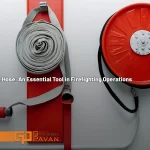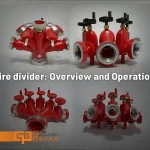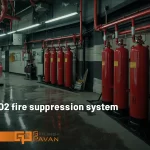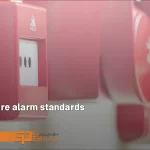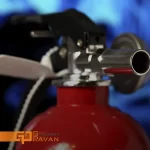In buildings, commercial, office, and industrial facilities, fire safety measures are essential to reduce possible risks in case of fire. Using standard and reliable equipment is one of the ways to mitigate these risks. For this reason, in this article from Ganjineh Pavan’s blog, we will review the EN 54 standard for fire detection and alarm systems and equipment.
EN54 standard and its history
Standardization issues related to fire protection were among the first to be addressed by CEN – the French acronym for Comité Européen de Normalisation, which means the European Committee for Standardization.
CEN numbers European standards in ascending numerical order according to the date of project registration. The standard of firefighting classes is EN 2 and the series of standards related to portable fire extinguishers is EN 3. European standardization of fire detection and alarm systems began in the 1970s. EN 54-1 and EN 54-5 were issued in 1976.
The Construction Products Regulation (CPR), officially the Construction Products Directive, is an EU law that covers thousands of products used as part of the construction of buildings.
Many of the EN 54 series product standards are harmonized standards under the Construction Products Regulation (CPR) EU 305/2011. Annex ZA of the harmonized standards specifies which parts of the standard application are for the purposes of the Construction Products Regulation (CPR).

What is the EN 54 standard?
Fire detection and alarm systems EN 54 is a set of European standards that include product standards and application guidelines for fire detection and fire alarm systems, as well as sound alarm systems.
EN54 defines product standards, product characteristics, test methods, and performance criteria based on which the effectiveness and reliability of each component of a fire detection and fire alarm system can be evaluated and declared.
The fire detection and alarm system standard EN 54 is a mandatory standard that specifies the requirements and laboratory tests for each component of the fire detection and fire alarm system and allows the free movement of construction products between EU market countries.
This standard is widely recognized around the world. The EN 54 standard is recognized in Latin American countries, Brazil, African and Asian countries, and several islands in the Pacific Ocean.
In Iran, the EN54 standard is one of the standards accepted by the national building regulations in the design, selection of equipment, and installation of fire detection and alarm systems. In this regard, Iran’s national building regulations have introduced the BS EN 5839-1 standard, which is a part of the EN54 standard, as one of the accepted references.
The importance of EN 54 fire detection and alarm systems standard
The European product standard EN 54 applies to all audio alarm systems, including loudspeakers, that are used manually or automatically in case of fire.
EN 54 standards guarantee production consistency, product performance, and reliability. Guaranteeing these items reassures customers and reduces the risk of a possible fire.
EN54 requirements describe the minimum quality standards required for fire alarm systems, from smoke detectors and visual signs to amplifiers and loudspeakers. This standard ensures that safety systems operate clearly and reliably in emergencies. For example, voice alarms, which send pre-recorded voice messages instead of a siren, are covered by two specific parts of EN 54-16, and EN 54-24.
Specific standards
To comply with the regulations, manufacturers are required to submit their products to third-party approved bodies to be tested for compliance with certain standards, which in the case of the audible alarm market include:
- EN 54-4: Power supply equipment
- EN 54-16: Electronic sound warning equipment
- EN 54-24: Loudspeakers
EN 54-16 standard
EN 54-16 specifies requirements for audio alarm controls and specifies equipment such as amplifiers and mixers that output audio alarm media to loudspeakers. Dedicated equipment providing audible warning media may also require approval of EN 54-4 for “Power supply equipment”. To ensure that power is not lost in case of emergency.
EN 54-24 standard
EN 54-24 describes the minimum acoustic and construction requirements for loudspeakers designed to transmit audible warning messages in an emergency.

BS EN 54 standard
BS EN 54 is a set of standards in force in the UK for the components of a permanent fire alarm system. There is a different part of the standard for each component.
Fire safety professionals will never specify a BS EN54-compliant fire alarm system, as BS EN54 in itself does not give you any indication of what a fire alarm system will look like in general. Instead, BS 5839-1 is used, which is part of BS EN54.
Standard BS 5839-1
Finally, to “design, install and operate” a fire detection and alarm system compliant with EN 54, contractors must consider and comply with BS 5839-1. This standard provides recommendations for the design, installation, and maintenance of systems in non-domestic locations.
Sections of BS EN-54 standards
The BS EN54 standard has 31 sections, each of which is related to a part of the design, equipment selection, installation, and maintenance of fire detection and alarm systems. The list of different parts of the EN 54 standard is as follows:
BS EN 54-1:2011 Introduction
BS EN 54-2:1997+A1:2006 Control and indicating equipment
Standard BS-EN 54-32001 Fire alarm equipment: siren
BS EN 54-4:1998 Power supply equipment
BS EN 54-5:2001 Thermal detectors: Point detectors
BS-EN 54-7:2001 Smoke detectors: point detectors using scattered light, transmitted light, or ionization
BS EN 54-10:2002 Flame detectors: Point detectors
BS EN 54-11:2001 Fire alarm systems
Standard BS-EN 54-12:2002 Smoke detectors: linear detectors using an optical beam
BS EN 54-13:2005 Assessment of compatibility of system components
BS EN 54-16:2008 Audible alarm control and indicating equipment

BS EN 54-17:2005 Short-circuit disconnectors
BS EN 54-18:2005 Input/output devices
Standard BS EN 5420:2006 Suction smoke detectors
BS EN 54-21:2006 Alarm transmission and fault alarm routing equipment
BS EN 54-22:2015 Resettable linear type thermal detectors
Standard BS EN 54-23:2010 Fire alarm equipment. Video warning devices
BS EN 54-24:2008 Components of audible warning systems: Loudspeakers
BS EN 54-25:2008 Components using radio links
Standard BS EN 54-26:2015 Point fire detectors using carbon monoxide sensors
BS EN 54-29:2015 Multi-sensor fire detectors – Point detectors using a combination of smoke and heat sensors
Standard BS EN 54-30:2015 Multi-sensor fire detectors – Point detectors using a combination of carbon monoxide and optional thermal detectors
BS EN 54-31:2014 Multi-sensor fire detectors – Point detectors using a combination of smoke, carbon monoxide, and optional heat sensors

Final word
In this article, from Ganjineh Pavan’s articles, we examined the EN 54 standard. This standard specifies the requirements for the design, installation, and maintenance of fire detection and alarm systems in the European Union, which is recognized worldwide as a valid standard.
In the design, selection of equipment, installation, and maintenance of detection and fire alarm systems, the BS 5839-1 standard, which is based on the EN 54 standard, is one of the acceptable references to Iran’s national building regulations.
Ganjineh Pavan provides consulting, design, supply, installation and implementation, testing, and maintenance services in the following fields:
- Design and installation of fire alarm system
- Design and installation of fire extinguishing system
- Supply, design, and installation of the F&G system
- Safety and personal protection equipment (PPE)
Consulting and obtaining fire department approval for the completion of building work
The experienced specialists of Ganjineh Pavan Company are ready to provide you with free advice for choosing equipment, designing and installing fire alarms, and extinguishing systems. To contact and receive free advice, please contact us through the contact page on Ganjineh Pavan website.
References:


